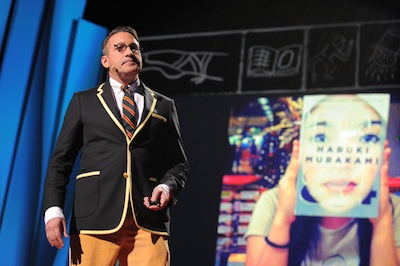Robots, Introverts and Haikus: The Top Talks At TED2012

Creating visual haikus for stories: Chip Kidd
(Video not yet available.)
Don’t judge a book by its cover. Chip Kidd, who has devoted 25 years of his life to designing books, may disagree with this old adage. The graphic designer began his career at the publishing house of Albert A. Knopf where he had to ask himself, “What do stories look like?” In his talk, the eccentric yet dashing Kidd took the audience on an entertaining tour of covers he has created over the years. He peppered his talk with delightful and sharp anecdotes behind his designs for many recognizable titles, from Haruki Murakami’s “1Q84” with its explorative overlapping covers to the underwear-clad skeleton featured on the cover of “Naked” by David Sedaris.
The story behind the design for Augusten Burroughs’ “Dry,” a book about the author confronting alcoholism, offered the most interesting peek into the designer’s creative process. Kidd wanted to create a sense of “typography in denial: it’s lying, desperately, hopelessly, the way an alcoholic would.” The execution of this concept involved a simple yet ingenious method: he printed out some type on a printer, taped it to a wall, and finally, threw a bucket of water on it. Apparently, Burroughs himself watched a lady take a copy of the book to a cashier in a bookstore. “This one’s ruined!” she exclaimed. The reply: “I know lady, they all came in that way.”
The power of introverts: Susan Cain
One of the most engaging speakers at TED was a self-described introvert. In fact, the very topic of Susan Cain's talk was how introverts bring extraordinary talents and abilities to the world and should be encouraged and celebrated.
“Solitude,” said Cain, “is a crucial ingredient often to creativity.”
To illustrate this point, the author brought up prominent introverted figures. Darwin, for example, would decline dinner invitations and instead preferred long walks alone in the woods.
According to Cain, Western societies tend to value “the man of action” over “the man of contemplation.” As a result, important institutions like schools and workplaces are designed for extroverts, often making introverts feel ashamed for wanting to be alone. Teamwork and social skills are important for solving the big economic and global problems we are facing, she said. But “the more freedom we give introverts to be themselves, the more likely they will be able to come up with their own unique solutions to these problems.”
Robots that fly...and cooperate: Vijay Kumar
What would TED be without cool inventions? In his presentation, Vijay Kumar demonstrated autonomous agile aerial robots, or in other words, flying robots. The machines, developed at the School of Engineering at the University of Pennsylvania, can fly and navigate on their own without a controller, and don’t let their small size fool you. According to Kumar, groups of robots can work together in accomplishing big tasks such as transporting cargo, assessing damage to buildings from earthquakes and being first responders to gaseous leaks.
The videos of the flying robots were the most engaging, showing them navigate obstacles like jumping through a hoop that someone throws into the air. In another video, a group of 20 robots hover and quickly move in a figure-eight motion. Kumar concluded the talk with a fun, impressive music video of a flying robot band playing six different instruments.
Remembering to remember: Joshua Foer
(Video not yet available.)
Joshua Foer began his talk by asking the audience to close their eyes and visualize a strange scenario in their home involving overweight nudists on bicycles, the Cookie Monster and Britney Spears. This is not a sign of Foer’s insanity, but tells the story of the science journalist’s journey into competitive memorizing. When covering a New York competition, he asked one of the contestants to train him. “It was,” said Foer, “the beginning of a very strange journey.”
He found that the secret was “elaborative encoding,” which is exactly the purpose behind the bizarre story he told. “Word for word will screw you up. It’s topic for topic,” said Foer. To memorize a speech, he explained, you could picture walking through your home and each strange character you encounter, such as the Cookie Monster, would remind you of a sequential topic.
The final message after all the fun was that it is most important to live a life remembered. “How much are we willing to lose from our already short lives by losing ourselves in our BlackBerries and our iPhones?” he asked. “To live a memorable life, you have to be the kind of person who remembers to remember.”
All of our survival is tied to the survival of everyone: Bryan Stevenson
(Video not yet available.)
The most applauded and inspiring talk at TED 2012 was in many ways about TED itself. Criminal justice lawyer and founder of the Equal Justice Initiative Bryan Stevenson delivered a compelling message on how the distinctively powerful TED platform could develop its identity and goals moving forward. He proposed that the TED community be courageous in integrating the “bright and dazzling” developments in technology and design with the “dark and depressing” realities of human suffering and degradation in society.
Stevenson illustrated such harsh realities with his knowledge and experience from working in the criminal justice system. According to the lawyer, the United States has the highest rate of incarceration in the world, with a staggering 50 to 60 percent of young men of color in jail, prison or on parole.
“In many parts of this country the opposite of poverty is not wealth. In too many places the opposite of poverty is justice,” said Stevenson. “We will ultimately not be judged by our technology and design, we will judge the character of our society, by how they treat the poor.”
Reach Staff Reporter Tricia Tongco here and follow her on Twitter.



